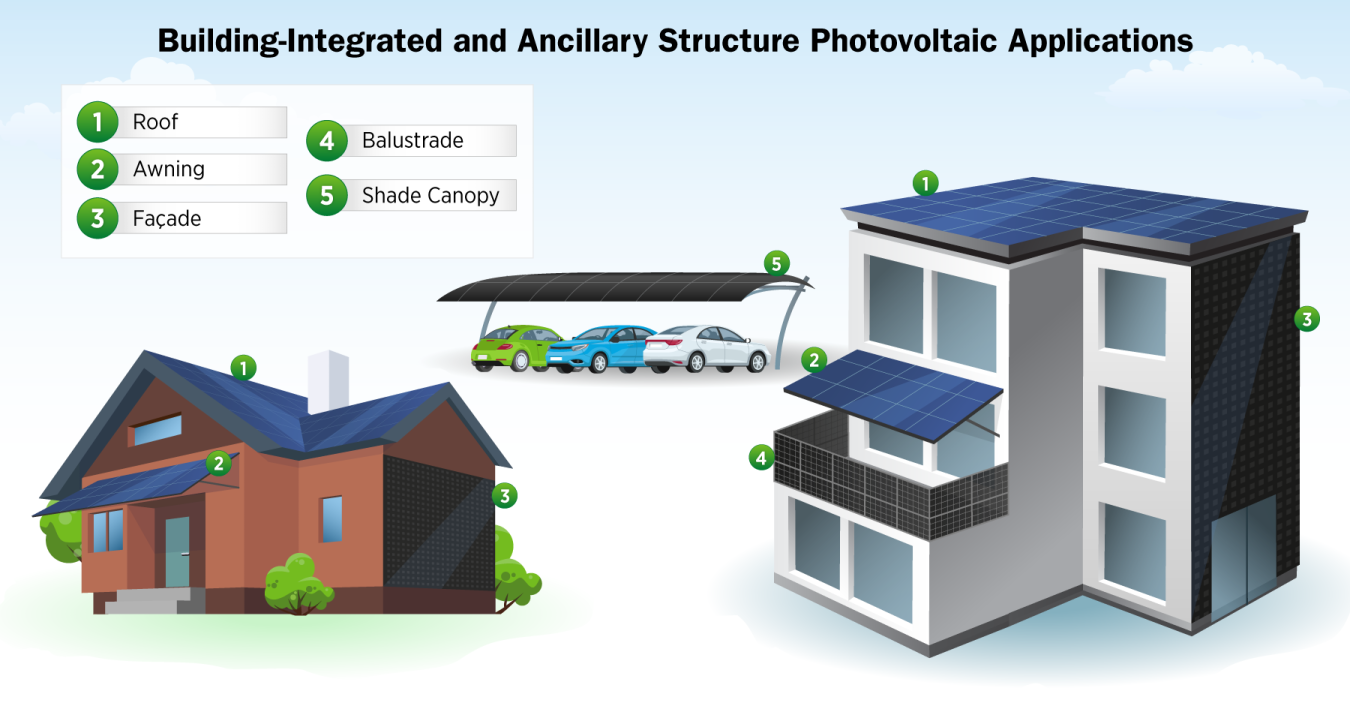When thinking of generating solar energy on buildings, most people think of rooftop solar panels—the rectangular, glass modules placed neatly on top of people’s homes. But solar technologies include much more than just rooftop panels, and building-integrated photovoltaics, also known as BIPV, takes the panel off the roof and, for example, puts it inside the roof itself.
Different from the traditional rooftop solar market, BIPV is a set of emerging solar energy applications that replace conventional building materials with solar generating materials in various parts of a structure, like the roof, skylights, balustrades, awnings, facades, or windows. Perhaps the most common forms of BIPV are carports or parking shade structures with PV panels built directly into them.

By generating clean energy onsite rather than sourcing electricity from the local electric grid, solar energy provides certainty on where your energy is coming from, can lower your electricity bills, and can improve grid resilience and reliability, among the many environmental and financial benefits of solar energy. But there’s more than one way to generate solar energy on a building and, in some cases, BIPV might make more sense than rooftop panels.
For example, some homeowners may have restrictive homeowner association rules that prohibit rooftop panels; certain commercial buildings may have roof weight limitations that rule out rooftop solar panels; and multi-story and high-rise buildings have much more exterior wall surface area than roof top area. In these cases, solar facades, parking structures, or awnings can be a great alternative to rooftop panels. Or maybe you just want to lounge under a solar awning on your net-zero home’s roof deck. In addition to the environmental benefit of generating your own electricity with solar energy, BIPV is an aesthetically pleasing, space-saving way for building owners to transition to renewable energy. On-building energy generation also reduces how much we need to invest in grid transmission and distribution infrastructure as our country transitions to all-electric buildings and vehicles, helping to keep energy prices affordable.
The U.S. Department of Energy (DOE) Solar Energy Technologies Office (SETO) is working to expand the opportunities and understand the challenges of BIPV technology. SETO’s 2022 BIPV Request for Information (RFI) collected stakeholder input and insights on BIPV opportunities, barriers, and standards. Following the RFI, DOE held several workshops to gather information, including Current Challenges, Opportunities, and Research Needs of BIPV Systems. The workshop engaged solar and buildings industry professionals to address the technology, policies, research, and infrastructure standards that can help propel BIPV technology forward. Other DOE workshops included the RE+ 2022 Workshop – Building-Integrated Photovoltaics (BIPV): Beyond the Shingle, and GreenBuild 2022 Workshop – Building-Integrated Photovoltaics: Beyond the Shingle.
DOE also supports advances in BIPV through its 2023 Dual-use Photovoltaics Incubator funding opportunity, which includes the development of products that can open new markets for emerging dual-use PV sectors, like BIPV. Additionally, an ongoing project with the Architectural Solar Association and the National Renewable Energy Laboratory (NREL) is developing a continuing education program that includes topics such as design and integration, implementation, and financial principles associated with integrating solar technology into the built environment. The content will encompass the full spectrum of integration opportunities from rooftop solar panels to building-integrated solar windows.
While BIPV is considered an emerging sector in solar energy, it has the potential to provide major benefits to consumers. The way we harness power from the sun can vary greatly—from agrivoltaics—the co-location of solar arrays and agriculture on the same land—to floatovoltaics—solar panels on floating structures, or solar photovoltaic and thermal technology (PVT) — which generate electricity and capture heat from sunlight in one device. DOE will continue its research in BIPV and other dual-use technologies to support U.S. solar manufacturing, spur innovation, and reduce the non-hardware “soft” costs and other barriers to equitable solar energy deployment.
Looking for more information on BIPV and other dual-use PV sectors? Learn about SETO’s Dual-Use Photovoltaic Technologies research and read the Building-Integrated Photovoltaics RFI Summary and Building-Integrated Photovoltaics Market Research Study.


